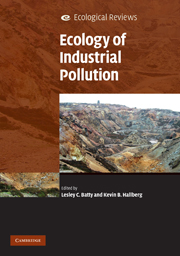Book contents
- Frontmatter
- Contents
- List of contributors
- Preface
- Acknowledgements
- 1 Consequences of living in an industrial world
- 2 Metallophytes: the unique biological resource, its ecology and conservational status in Europe, central Africa and Latin America
- 3 Lichens and industrial pollution
- 4 The impacts of metalliferous drainage on aquatic communities in streams and rivers
- 5 Impacts of emerging contaminants on the environment
- 6 Ecological monitoring and assessment of pollution in rivers
- 7 Detecting ecological effects of pollutants in the aquatic environment
- 8 With the benefit of hindsight: the utility of palaeoecology in wetland condition assessment and identification of restoration targets
- 9 An ecological risk assessment framework for assessing risks from contaminated land in England and Wales
- 10 Diversity and evolution of micro-organisms and pathways for the degradation of environmental contaminants: a case study with the s-triazine herbicides
- 11 The microbial ecology of land and water contaminated with radioactive waste: towards the development of bioremediation options for the nuclear industry
- 12 The microbial ecology of remediating industrially contaminated land: sorting out the bugs in the system
- 13 Ecological recovery in a river polluted to its sources: the River Tame in the English Midlands
- 14 Manchester Ship Canal and Salford Quays: industrial legacy and ecological restoration
- 15 Large-scale mine site restoration of Australian eucalypt forests after bauxite mining: soil management and ecosystem development
- 16 Sustaining industrial activity and ecological quality: the potential role of an ecosystem services approach
- Index
- Plate section
- References
9 - An ecological risk assessment framework for assessing risks from contaminated land in England and Wales
Published online by Cambridge University Press: 05 June 2012
- Frontmatter
- Contents
- List of contributors
- Preface
- Acknowledgements
- 1 Consequences of living in an industrial world
- 2 Metallophytes: the unique biological resource, its ecology and conservational status in Europe, central Africa and Latin America
- 3 Lichens and industrial pollution
- 4 The impacts of metalliferous drainage on aquatic communities in streams and rivers
- 5 Impacts of emerging contaminants on the environment
- 6 Ecological monitoring and assessment of pollution in rivers
- 7 Detecting ecological effects of pollutants in the aquatic environment
- 8 With the benefit of hindsight: the utility of palaeoecology in wetland condition assessment and identification of restoration targets
- 9 An ecological risk assessment framework for assessing risks from contaminated land in England and Wales
- 10 Diversity and evolution of micro-organisms and pathways for the degradation of environmental contaminants: a case study with the s-triazine herbicides
- 11 The microbial ecology of land and water contaminated with radioactive waste: towards the development of bioremediation options for the nuclear industry
- 12 The microbial ecology of remediating industrially contaminated land: sorting out the bugs in the system
- 13 Ecological recovery in a river polluted to its sources: the River Tame in the English Midlands
- 14 Manchester Ship Canal and Salford Quays: industrial legacy and ecological restoration
- 15 Large-scale mine site restoration of Australian eucalypt forests after bauxite mining: soil management and ecosystem development
- 16 Sustaining industrial activity and ecological quality: the potential role of an ecosystem services approach
- Index
- Plate section
- References
Summary
Introduction
An ecological risk assessment (ERA) may be described as ‘a process that evaluates the likelihood that adverse ecological effects may occur or are occurring as a result of exposure to one or more stressors’ (USEPA 1992, 1998). Arguably the most common stressors are chemical contaminants, and regulatory authorities in many countries around the world use ERA schemes to determine whether chemical contaminants are impacting on ecological systems. The USA, the Netherlands, Canada, Australia, New Zealand and the UK have all spent considerable resources developing ERAs for use under their respective regulatory regimes. But, although each country has developed its ERA schemes for its own specific regulatory needs, the approach taken is broadly similar for all ERAs.
The largest programme of work to develop ERA frameworks is that of the United States Environmental Protection Agency (USEPA), which started in the mid 1980s. Typically, the USEPA ERA follows three basic steps: problem formulation, analysis and risk characterization (USEPA 1998). The ERA process has been further adapted for use at EPA Superfund sites, to include eight specific steps, from screening level evaluations to full site investigations and risk management (USEPA 1999). Marking ten years of use in the United States, the USEPA has recently assessed how well the ERA guidelines have worked, identifying strengths and weaknesses (see Dale et al. 2008; Kapustka 2008; Suter & Cormier 2008).
- Type
- Chapter
- Information
- Ecology of Industrial Pollution , pp. 189 - 204Publisher: Cambridge University PressPrint publication year: 2010
References
- 1
- Cited by



